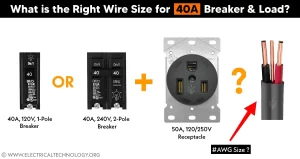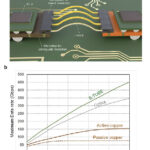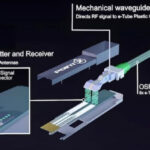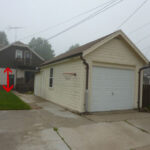Choosing the correct wire size for a 40 amp breaker is essential for electrical safety, code compliance, and proper system performance. Whether you're installing an electric range, heat pump, or subpanel, this comprehensive guide covers everything you need to know about 40 amp wire sizing and installation requirements.

what size wire for 40 amp breaker
Quick Answer: Wire Sizes for 40 Amp Breakers
For standard 40 amp electrical circuits, you need:
- 8 AWG copper wire for most residential applications
- 6 AWG aluminum wire for equivalent ampacity
- 6 AWG copper wire for long runs or high-temperature conditions
These sizes meet National Electrical Code (NEC) requirements and provide safe operation under normal conditions.
Understanding 40 Amp Wire Requirements
The NEC mandates that wire ampacity must equal or exceed the breaker rating. For 40 amp breakers, 8 AWG copper wire with a standard ampacity of 50 amps provides the required capacity with a safety margin.
Standard Ampacity Ratings:
- 8 AWG copper: 50 amps
- 6 AWG copper: 65 amps
- 6 AWG aluminum: 50 amps
- 4 AWG aluminum: 65 amps
This built-in safety margin ensures the wire can handle the full 40 amp load without overheating under normal operating conditions.
Common Applications for 40 Amp Circuits
Kitchen and Cooking Appliances
- Electric ranges and cooktops
- Double wall ovens
- Large commercial-style ranges
- Built-in cooktop and oven combinations
HVAC Equipment
- Central air conditioning units
- Heat pump systems
- Electric furnaces
- Large ductless mini-split systems
Water Heating Systems
- Electric water heaters (40-50 gallon tanks)
- Tankless electric water heaters
- Pool and spa heaters
- Radiant floor heating systems
Electrical Subpanels
- Garage subpanels
- Workshop electrical panels
- Detached building service
- Home addition electrical systems
High-Power Equipment
- Electric vehicle charging (Level 2)
- Welding equipment
- Large air compressors
- Industrial machinery
Factors That Affect Wire Size Selection
Distance and Voltage Drop
Wire size requirements increase with distance to prevent voltage drop:
- Up to 75 feet: 8 AWG copper typically sufficient
- 75-150 feet: Consider 6 AWG to minimize voltage drop
- Over 150 feet: Voltage drop calculations essential
- Long runs: May require oversized wire for voltage stability
Ambient Temperature Conditions
High temperatures reduce wire ampacity:
- Hot attics: May require derating to 6 AWG
- Underground installations: Soil temperature affects capacity
- Bundled cables: Multiple wires generate additional heat
- Direct sunlight: Outdoor installations need UV-resistant wire
Installation Method
How wire is installed affects its current-carrying capacity:
- Free air installation: Full ampacity rating applies
- Conduit with multiple circuits: Derating factors required
- Direct burial: Special cable types and sizing needed
- Overhead installation: Wind and weather considerations
Continuous Load Applications
For equipment running more than 3 hours continuously:
- 125% rule: Wire must handle 125% of continuous load
- 50 amp capacity needed: For 40 amp continuous loads
- Upsizing required: May need 6 AWG instead of 8 AWG
- Examples: Electric baseboard heat, some HVAC equipment
Wire Types for 40 Amp Installations
THWN-2 Individual Conductors
- Conduit installation: Used with metal or PVC conduit
- High temperature rating: 90°C wet/dry locations
- Versatile application: Suitable for most installations
- Color coding: Helps identify hot, neutral, and ground conductors
Romex/NM Cable (Non-Metallic)
- 8-3 or 8-2 configurations: Depending on circuit requirements
- Residential applications: Common for range and dryer circuits
- Easy installation: Pre-assembled cable with ground
- Cost effective: Less expensive than individual conductors
SER/SEU Service Entrance Cable
- Subpanel applications: From main panel to subpanel
- Aluminum or copper: Available in both conductor materials
- Pre-assembled: Includes neutral and ground conductors
- Outdoor rated: Suitable for exterior installations
MC Cable (Metal Clad)
- Flexible metal sheathing: Provides physical protection
- Commercial applications: Often required in commercial buildings
- Exposed installations: Good for visible wire runs
- Fire resistance: Metal sheathing provides fire protection
Copper vs. Aluminum Wire Comparison
Copper Wire Advantages
- Superior conductivity: Higher ampacity per wire size
- Corrosion resistance: Longer lifespan in most environments
- Standard connections: Compatible with all standard terminals
- Flexibility: Easier to bend and install
Aluminum Wire Considerations
- Cost savings: Significantly less expensive than copper
- Larger physical size: 6 AWG aluminum vs. 8 AWG copper
- Special terminals: Requires AL-rated connections
- Thermal expansion: More expansion/contraction than copper
- Oxidation concerns: Requires antioxidant compound
Installation Requirements and Code Compliance
National Electrical Code Standards
- Minimum wire size: Must meet or exceed 40 amp capacity
- Grounding requirements: Proper equipment grounding conductor
- Protection methods: Appropriate overcurrent protection
- Installation practices: Approved wiring methods and materials
Equipment Grounding Conductor
For 40 amp circuits, the equipment grounding conductor size:
- 10 AWG copper: For 8 AWG circuit conductors
- 8 AWG aluminum: Equivalent grounding capacity
- Separate conductor: In conduit installations
- Integrated: In cable assemblies like Romex
GFCI and Arc Fault Protection
- GFCI requirements: Outdoor installations and specific locations
- Arc fault protection: May be required for certain applications
- Combination devices: GFCI/AFCI combination breakers available
- Code updates: Requirements continue to expand
Professional Installation Considerations
Electrical Permits and Inspections
Most 40 amp installations require:
- Building permits: Required in most jurisdictions
- Plan review: Complex installations may need approval
- Inspection schedule: Rough-in and final inspections
- Certificate of occupancy: Final approval for occupancy
Licensed Electrician Requirements
Professional installation recommended for:
- Panel modifications: Adding new breakers
- High-voltage circuits: 240V installations
- Complex routing: Through finished walls
- Code compliance: Ensuring proper installation
Load Calculations
- Total panel capacity: Ensure adequate service capacity
- Demand factors: Apply appropriate load calculations
- Future expansion: Plan for additional electrical needs
- Utility requirements: May affect service sizing
Cost Analysis for 40 Amp Wire Installation
Material Costs (per foot)
- 8 AWG copper Romex: $2-4
- 8 AWG THWN copper: $1.50-3
- 6 AWG aluminum SER: $1.50-2.50
- Conduit and fittings: $1-2 additional per foot
Installation Cost Factors
- Professional installation: $800-2,500 typical range
- Distance and complexity: Longer runs cost more
- Permit and inspection fees: $75-300 depending on location
- Panel modifications: $200-500 for new breaker installation
Long-term Value
- Safety investment: Prevents electrical hazards
- Code compliance: Meets current safety standards
- Property value: Professional electrical work adds value
- Energy efficiency: Proper sizing reduces energy loss
Safety Guidelines and Best Practices
Installation Safety
- Power disconnection: Always turn off power at main breaker
- Proper tools: Use insulated tools and safety equipment
- Personal protection: Wear safety glasses and gloves
- Code compliance: Follow all applicable electrical codes
Wire Handling and Connection
- Proper stripping: Don't nick or damage conductors
- Tight connections: Ensure all connections are secure
- Torque specifications: Follow manufacturer's torque requirements
- Inspection: Visually inspect all connections before energizing
Testing and Verification
- Continuity testing: Verify proper connections before energizing
- Insulation testing: Check for shorts or ground faults
- Voltage verification: Confirm proper voltage at load
- Load testing: Test equipment operation under full load
Common Installation Mistakes to Avoid
Wire Sizing Errors
- Undersized wire: Using 10 AWG instead of 8 AWG
- Ignoring voltage drop: Not accounting for long runs
- Temperature factors: Not derating for high temperatures
- Aluminum connections: Using copper-only terminals
Installation Problems
- Poor connections: Loose or improperly made connections
- Inadequate support: Not supporting cables properly
- Code violations: Not following installation requirements
- Missing protection: Inadequate overcurrent protection
Planning Oversights
- Insufficient capacity: Not planning for future loads
- Access issues: Creating maintenance problems
- Permit problems: Proceeding without required permits
- Inspection failures: Not scheduling required inspections
Troubleshooting 40 Amp Circuit Issues
Breaker Problems
- Frequent tripping: Circuit overload or equipment malfunction
- Won't reset: Short circuit or ground fault condition
- Warm breaker: Loose connections or overloaded circuit
- Arcing sounds: Immediate professional attention required
Voltage Issues
- Low voltage: Check for loose connections or voltage drop
- Voltage fluctuations: May indicate overloaded circuit
- No voltage: Breaker tripped or connection failure
- Unbalanced voltage: Problems with 240V circuit balance
Equipment Performance
- Reduced performance: May indicate voltage drop or overloading
- Intermittent operation: Loose connections or thermal issues
- Equipment damage: Improper voltage or protection
- Unusual noises: Possible arcing or equipment problems
Maintenance and Long-term Care
Regular Inspections
- Annual visual inspection: Look for signs of overheating
- Connection tightness: Check all accessible connections
- Breaker operation: Test breaker operation periodically
- Load monitoring: Ensure circuit isn't overloaded
Professional Maintenance
- Thermal imaging: Professional inspection for hot spots
- Connection torque: Periodic tightening of connections
- Load analysis: Professional load calculations
- System upgrades: Planning for future electrical needs
Future Planning and Upgrades
Technology Considerations
- Smart breakers: Monitor circuit usage and performance
- Energy monitoring: Track electrical consumption
- Automation systems: Integration with home automation
- Renewable energy: Solar panel and battery system integration
Capacity Planning
- Load growth: Plan for increasing electrical demands
- Equipment upgrades: Consider future appliance needs
- System expansion: Plan for additional circuits
- Service upgrades: May require electrical service increases
Environmental and Efficiency Considerations
Energy Efficiency
- Proper wire sizing: Minimizes energy losses
- Quality materials: Use high-quality wire and connections
- Load balancing: Optimize electrical system efficiency
- Power factor: Consider power factor correction for motor loads
Sustainable Practices
- Material selection: Choose environmentally responsible materials
- Recycling: Properly dispose of old electrical materials
- Energy conservation: Efficient electrical systems reduce consumption
- Future-proofing: Plan for renewable energy integration
Conclusion
Selecting 8 AWG copper wire for 40 amp breakers provides safe, code-compliant electrical service for most residential applications. However, factors like distance, temperature, and installation method may require larger wire sizes to ensure optimal performance and safety.
Professional installation is strongly recommended for 40 amp circuits due to the high current levels and potential safety hazards. Proper wire sizing, installation, and code compliance protect your property and family while ensuring reliable electrical service.
Always consult with licensed electricians and local building departments to ensure your installation meets all applicable codes and safety requirements. The investment in proper wire sizing and professional installation provides the foundation for safe, efficient electrical systems that will serve your needs for decades.
Frequently Asked Questions
Q: Can I use 10 AWG wire for a 40 amp breaker? A: No, 10 AWG wire is only rated for 30 amps maximum. You must use at least 8 AWG copper or 6 AWG aluminum for 40 amp circuits.
Q: What's the difference between 8 AWG and 6 AWG wire for 40 amp circuits? A: 8 AWG copper meets the minimum requirements, while 6 AWG provides extra capacity for long runs, high temperatures, or continuous loads.
Q: How far can I run 8 AWG wire on a 40 amp circuit? A: For most applications, 8 AWG copper can run up to 75 feet without significant voltage drop. Longer runs may require 6 AWG wire.
Q: Do I need a permit to install a 40 amp circuit? A: Most jurisdictions require permits for 40 amp circuit installations, especially for new circuits or panel modifications. Check with your local building department.
Q: Can aluminum wire be used for 40 amp circuits? A: Yes, 6 AWG aluminum wire can be used for 40 amp circuits, but it requires special AL-rated terminals and proper installation techniques.





